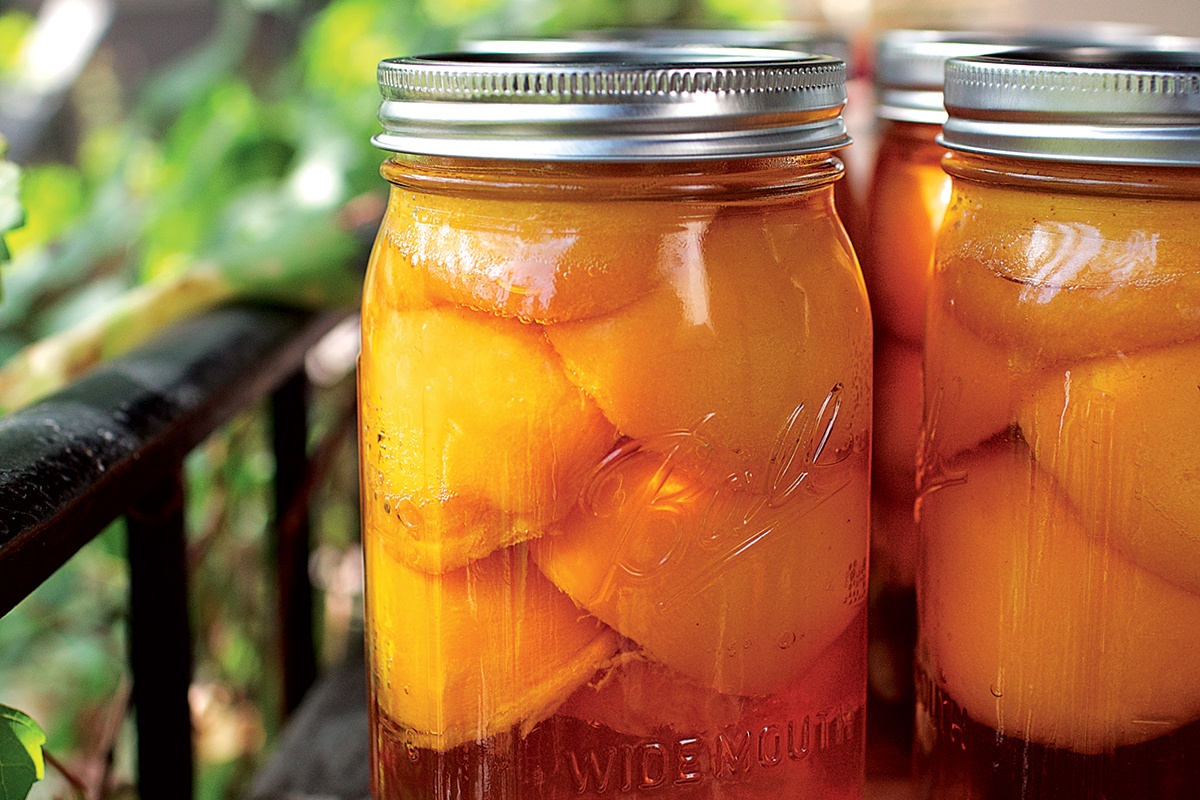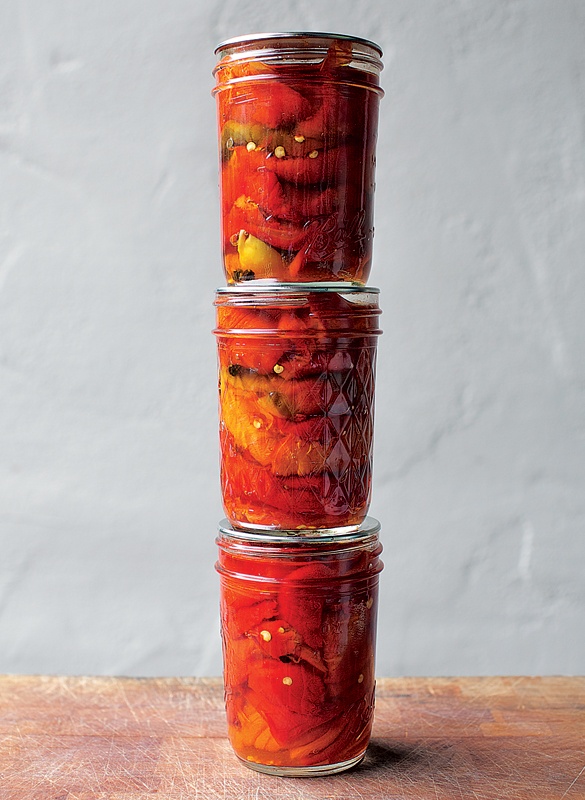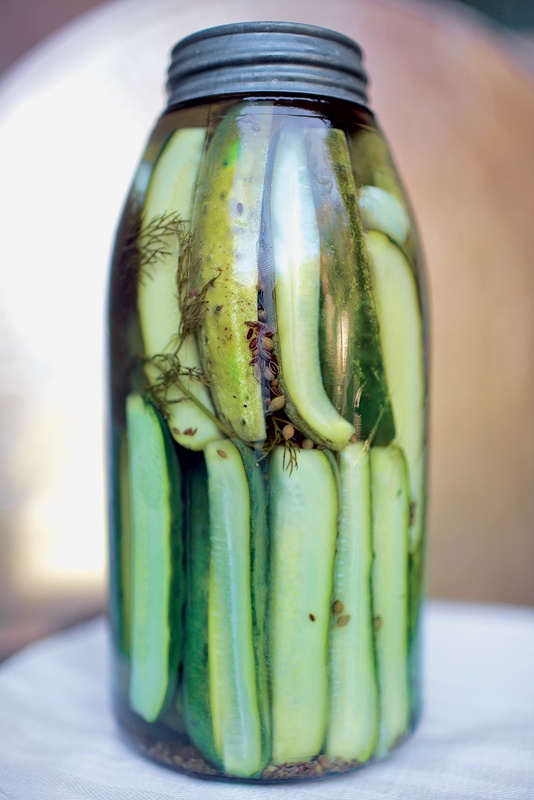David Kent grew up eating preserved produce in Eastern Tennessee. He’s the author of “Saving the Season” [Knopf, 2013] and writes a blog by the same name.
Here are three recipes from his book:
White Peach Halves in Lavender Syrup (Cold Pack)
2 stems dried lavender flowers (about 1 teaspoon florets)
4 1/2 cups water
2 cups sugar
5 1/2–6 pounds white peaches
2 tablespoons freshly squeezed lemon juice, or ½ teaspoon citric acid
1. Wrap the lavender in a cheesecloth pouch and put it in a pot with the water and sugar. Bring the syrup to a boil, then remove from the heat and cover until needed.
2. Slash an “X” in the pointed end of each peach. Working in batches, blanch them in boiling water for 60 to 90 seconds, until the skin loosens. Lift them out with a slotted spoon and drain. When they are cool, peel and pit the peaches. Cut them into halves or slices, as you like. Halves are prettier to serve; slices are easier to handle. Place the peaches as you slice them in a quart of water acidified with the lemon juice or citric acid.
3. Remove the lavender from the syrup, squeeze it to extract its flavor, and discard. Bring the syrup to a boil. Pack the peaches into four prepared quart jars or eight prepared pint jars. When a jar is about one-third full, cover with some hot syrup and shake to settle the peaches. Repeat until full, leaving 1/2 inch headspace. Run a skewer or other thin implement around the inside edge of the jar to release any air pockets and top up with syrup if necessary. Seal the jars, and process in a boiling-water bath for 25 minutes for pint jars, 30 minutes for quarts. To reduce venting, turn off the heat and let the jars rest in the water for 5 minutes before removing.
Yields 4 quarts.
Roasted Jalapeños En Escabeche
“En escabeche is the Spanish for “marinated” and derives from an Arabic term, al-sikbaj, for a sweet-sour dish that arrived in Spain with the Moorish conquest. Wear rubber gloves when you peel and seed the jalapenos. I didn’t once and regretted it until the next afternoon. Green jalapenos would also work.”
3 pounds red jalapeno peppers
2 cups white-wine vinegar
1 tablespoon honey
1 teaspoon kosher salt
1 teaspoon dried Mexican oregano
4 cloves garlic, peeled
20 black peppercorns
4 small bay leaves
4 tablespoons extra-virgin olive oil
1. Scorch the whole peppers directly over wood coals or underneath the broiler, turning them until they are blackened and wrinkled all over. Place them in a sealed container to steam for 15 minutes.
2. Once they’re cool, cut away the stems and, wearing rubber gloves, slice each jalapeño open to remove the seeds—the hottest part—and white connective tissue. Peel or rub off the charred skins. Tear the cleaned peppers into strips. Set aside.
3. Combine the vinegar, honey, salt and oregano in a saucepan, and bring to a boil. Turn off the heat, and let it sit, covered, for 15 minutes.
4. Place a garlic clove, 5 peppercorns and 1 small bay leaf into each of four prepared 1/2-pint jars. Loosely pack the peppers into the jars, leaving 3/4 inch headspace.
5. Bring the vinegar syrup back to a boil, and ladle the hot liquid through a strainer (to catch the oregano) into the jars, leaving a generous 1/2 inch headspace. Run a bamboo skewer or other thin implement around the inside edge of the jar to release air pockets. Pour a tablespoon of olive oil into each jar, and top up with more syrup to leave 1/2 inch headspace. Do not overfill.
6. Wipe the rims clean with a paper towel moistened with vinegar, seal, and process in a boiling-water bath for 10 minutes. Alternatively, for a firmer texture, process in a hot water bath, between 180 and 185 degrees, for 30 minutes.
Yields 2 pints.
Cucumber Dill Spears and Chips
“These dill pickle spears—or sandwich chips, depending on how you slice them—can be processed, if you want, for long-term shelf storage, but first try making a batch to keep in the refrigerator. They will be crisp, and the flavor of raw cucumber comes through.”
1/4 cup kosher salt
6 cups lukewarm water
2 teaspoons coriander seeds
½ teaspoon fennel seeds
3 large flowering dill heads (4 inches across)
3 pounds Kirby pickling cucumbers
4 cloves garlic, crushed
2 cups white-wine vinegar
1. Dissolve the salt in the water, and add the coriander, fennel and dill. Set aside.
2. Scrub the cucumbers well, rubbing off any spines. Cut away a thin round from the stem and blossom ends and slice lengthwise into quarters. Put the spears in a large bowl and cover with the brine. Weight the cucumbers with a plate, cover the bowl with a kitchen towel and set aside for 24 hours. If the bowl won’t fit in your refrigerator, it’s fine to leave it out at room temperature.
3. The next day, pack the cucumber spears into two scalded quart jars, saving the brine. Measure out 2 cups of the brine and reserve. Strain the remaining brine through a fine sieve to capture the aromatics and divide them between the jars. Tuck a dill head and two cloves of garlic into each jar.
4. Mix the vinegar and the 2 cups reserved brine, and bring to a boil. Pour it over the pickles to cover. Seal the jars and store in the refrigerator for a week before using. For long-term shelf storage, leave ½ inch headspace when filling the jars, then seal. Process in a boiling-water bath for 10 minutes, or in a hot-water bath, between 180 to 185 degrees, for 30 minutes.
Note: Instead of spears, you could slice your cucumbers into round coins, lengthwise “slabs” or bias-cut ovals. Make the slices 3/8 inch thick and soak them in the brine for 12 hours instead of 24.
Yields 2 quarts.



